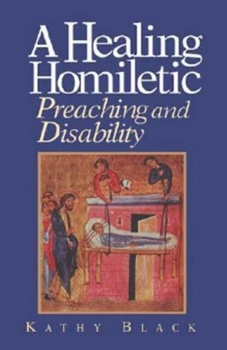A Healing Homiletic
In A Healing Homiletic: Preaching and Disability, Kathy Black offers a unique and effective approach for preaching about disabilities. By going to the heart of the gospel and drawing on the healing narratives or miracle stories, Black shows how preaching affects the inclusion or exclusion of forty-three million persons with disabilities from our faith communities. A Healing Homiletic provides a new method of preaching about healing, based on Scripture,...
Format:Paperback
Language:English
ISBN:0687002915
ISBN13:9780687002917
Release Date:October 1996
Publisher:Abingdon Press
Length:192 Pages
Weight:0.70 lbs.
Dimensions:0.5" x 5.5" x 8.5"
Customer Reviews
1 rating
Be healed!
Published by Thriftbooks.com User , 20 years ago
Kathy Black, a United Methodist minister on faculty at Claremont School of Theology, has had experience working with peoples with disabilities in both school and pastoral settings. According to Black, there are over 43 million persons with disabilities in the United States (and many more further afield in the world) who are affected by the interpretations and preaching of miracle and healing stories. How are these people addressed, as part of the congregations? How are the stories that talk about Jesus' healings to be taken by those who are blind or deaf or lame, who hear of such persons like themselves being cured, and yet when they leave the worship service, their disability is still with them?Healings have often been seen as a sign of the miraculous power of God. By healings, most people and theological interpretations have meant cures, physical and incarnate cures. There are those in the world who have played and preyed upon the desires for such cures; responsible theologians and pastors often speak with a sense of honest unease in dealing with questions such as 'why didn't God cure me?' Black looks at the healing narratives in the biblical text as being forms of liberation. At the same time, these same stories seem to reinforce the physical oppression to those with disabilities today. Both conservative and liberal camps fall short here. Those healed in the biblical texts are often portrayed as means to an end, rather than as persons with their own needs and histories in and of themselves. In the first part of the text, Black looks at theological perspectives on disability and God's relationship and responsibility - is this a punishment of some sort (of the person, or the person's family or community)? Is it some sort of curse, or test, or an opportunity? Black develops a theology of interdependence, a very communal-oriented theology, that looks for the work of inclusion in an accepting and supportive community, clearly identifying that disabilities do not come from God's intentional action for suffering. Secondly, Black looks at hermeneutical approaches, drawing a spectrum from literalism to metaphorical interpretations, locating most mainline preachers in the middle somewhere, not always a constant location for any particular preacher over time. She examines the different ways medical and disability issues are perceived from the time of the biblical text to today's society. The second major part of the text looks at specific disabilities - blindness, deafness, paralysis (lameness), leprosy (and other chronic illnesses), and mental illness. For each disability, a chapter is devoted with gospel texts, hermeneutic approaches, traditional homiletics and proposed healing approaches. Most of Black's texts come from the book of Mark, but there are representative passages from John and Luke as well. The persons with disabilities in these sections are described in modern terms rather than ancient terms. The 'traditional' hermeneu





